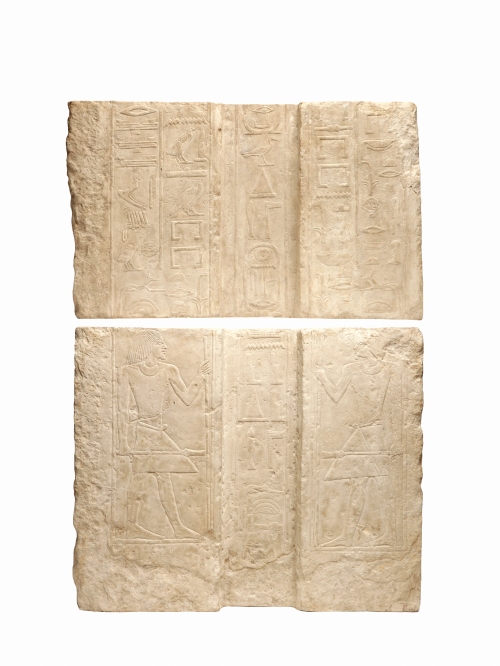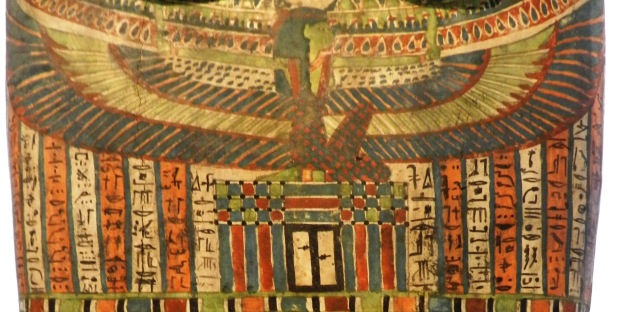https://egyptmanchester.wordpress.com/2018/11/14/object-biography-23-a-false-door-of-kha-inpu-acc-no-tn-r4567-1937/
Object Biography #23: A False Door of Kha-Inpu (Acc. no. TN R4567/1937)
This pair of finely executed limestone reliefs comes from a larger false door emplacement. They entered the Manchester Museum from the collection of pharmaceutical baron Sir Henry Wellcome (1853-1936), whose vast numbers of objects apparently included material acquired from the collection of Victorian socialite Lady Meux (1847-1910) – including the present object. Pieces from the same tomb chapel are now in the Field Museum of Chicago and the Louvre. When first identified in the Wellcome collection, the limestone was marred by salt encrustations. Fortunately it has now been conserved.

The false door of Kha-Inpu
The purpose of the false door was to channel the presence of the deceased (or of a deity in some temples) into a sacred space in order to receive offerings. The eternal needs of the 'ka' (the spirit of sustenance) mirrored to some extent the needs of the living to interact with the deceased, and the relationship between the two were hoped to be reciprocal. The false door was thus the focal point of the architecture of the elite Old Kingdom tomb chapel, although the false door motif continues on the sides of Middle Kingdom coffins and even appears on those of the Late Period. Depicting a door remained a key metaphysical conduit between the worlds of the dead or divine and the living.

The false door motif on the coffin of Asru, c. 650 BC
In design, stone false doors varied considerably over time but tended to include several key elements: the recessed and bolted door itself, a curved drum above this, usually with the name of the deceased, and a central offering scene showing the deceased (and sometimes their spouse) seated at a table. The image, name and titles of the deceased are often repeated multiple times – perhaps to ensure that were one or other damaged then the spirit of the deceased would 'survive' through the others, although this is conjecture and apparently not stated explicitly in the ancient sources.
Here, Kha-Inpu is designated as the 'overseer of the gold of the storehouse of the double house of the palace', a role associated with resource management – a typical concern for the redistribution of goods that temples had even in the Old Kingdom. He served the cults centred on pyramids of the deceased Fifth Dynasty kings Neferirkare and Niuserre, located just next to each other at the site of Abusir. The ancient name of the pyramid temple of King Niuserre was Men-sut-Niuserre ('Enduring are the Places of Niuserre') and that of King Neferirkare, Ba-Neferirkare ('Soul of Neferirkare'). A Czech Mission at Abusir recently identified the location of Kha-inpu's tomb there, although previously it has been thought to have been located at Saqqara. We know about the functioning of the cultic activities in which Kha-inpu is likely to have been involved from the 'Abusir archive', a rich and important set of papyrus documents detailing the organisation of temple staff and their regular duties.

The pyramids of (l-r) Neferirkare, Niuserre and Sahure at Abusir, with Giza (the arrangement on which they appear to have been modelled) behind. Photo: Ian Mathieson
The active, temple-based worship of Niuserre may have survived into the Middle Kingdom, with the presence of the tombs of two officials named Herishefhotep indicating that a functioning cult for the king lasted into at least the First Intermediate Period. The Manchester false door is an eloquent – and very finely-executed – testament to that cult.
Although our Ancient World galleries are temporarily closed, I am re-starting the Object Biography series with this post – which will be published in parallel by Ancient Egypt Magazine.
-- Sent from my Linux system.
No comments:
Post a Comment